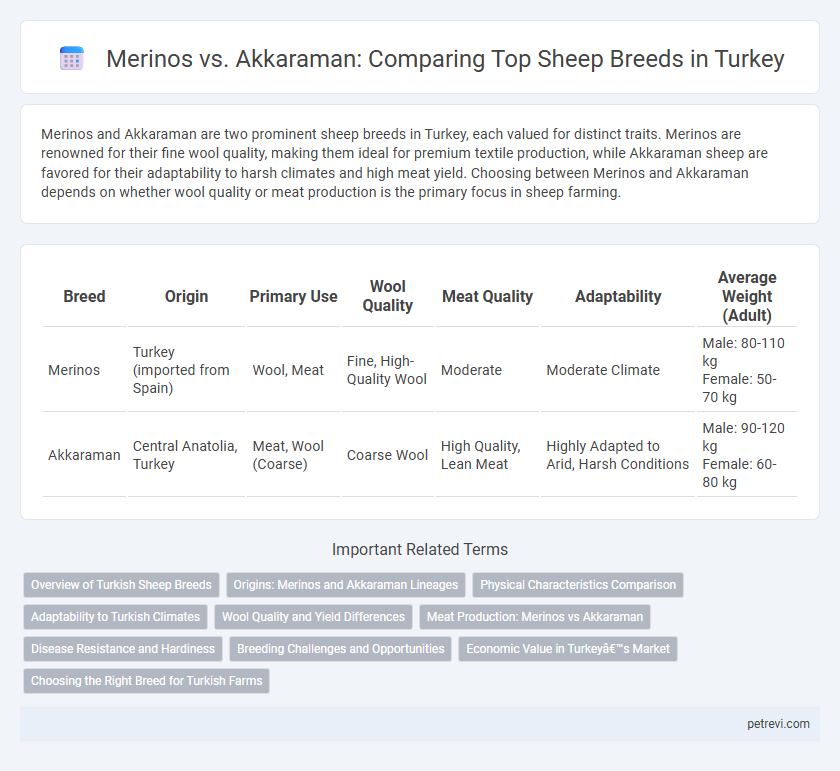Merinos and Akkaraman are two prominent sheep breeds in Turkey, each valued for distinct traits. Merinos are renowned for their fine wool quality, making them ideal for premium textile production, while Akkaraman sheep are favored for their adaptability to harsh climates and high meat yield. Choosing between Merinos and Akkaraman depends on whether wool quality or meat production is the primary focus in sheep farming.
Table of Comparison
| Breed | Origin | Primary Use | Wool Quality | Meat Quality | Adaptability | Average Weight (Adult) |
|---|---|---|---|---|---|---|
| Merinos | Turkey (imported from Spain) | Wool, Meat | Fine, High-Quality Wool | Moderate | Moderate Climate | Male: 80-110 kg Female: 50-70 kg |
| Akkaraman | Central Anatolia, Turkey | Meat, Wool (Coarse) | Coarse Wool | High Quality, Lean Meat | Highly Adapted to Arid, Harsh Conditions | Male: 90-120 kg Female: 60-80 kg |
Overview of Turkish Sheep Breeds
Merinos and Akkaraman are two prominent Turkish sheep breeds known for their distinct characteristics and economic importance. Merinos sheep are prized for their fine wool quality, contributing significantly to Turkey's textile industry, while Akkaraman sheep are valued for their adaptability to harsh climates and high meat yield. These breeds exemplify Turkey's diverse livestock resources, supporting both local agriculture and export markets.
Origins: Merinos and Akkaraman Lineages
Merinos sheep in Turkey trace their origins to Spain, brought to the region during the Ottoman period, renowned for their fine wool and adaptation to varied climates. Akkaraman sheep, indigenous to Anatolia, exhibit deep genetic roots tied to ancient Central Asian breeds, prized for hardiness and meat quality. Both breeds represent significant genetic diversity within Turkey's sheep populations, with Merinos emphasizing wool production and Akkaraman excelling in resilience and local adaptation.
Physical Characteristics Comparison
Merinos sheep in Turkey exhibit fine, dense wool with a creamy white fleece, typically weighing around 3 to 5 kg per shearing, and have a medium-sized body with a well-proportioned frame. Akkaraman sheep, native to Turkey, are larger and more robust, characterized by a coarse, less dense wool and a brownish or reddish coat, with a heavier body weight suited for meat production. The Merinos' slender legs and tighter fleece contrast sharply with the Akkaraman's sturdy legs and thicker, more resilient wool ideal for harsh climates.
Adaptability to Turkish Climates
Merinos sheep demonstrate moderate adaptability to Turkey's varied climate, thriving particularly in regions with cooler, more temperate conditions thanks to their dense wool and resilience to cold. Akkaraman sheep exhibit superior adaptability across diverse Turkish climates, excelling in arid and semi-arid environments common in Central Anatolia due to their hardy constitution and ability to withstand heat and drought. The Akkaraman breed's robust nature and efficient grazing habits make it better suited for the harsher Turkish plateau climate compared to the more specialized Merinos breed.
Wool Quality and Yield Differences
Merinos sheep in Turkey produce fine, high-quality wool with an average fiber diameter of 18-22 microns, valued for its softness and textile applications, yielding around 3-5 kg of wool per shearing. Akkaraman sheep, adapted to arid regions, yield coarser wool averaging 30-35 microns in diameter, with lower wool quality but greater resilience, producing approximately 1-2 kg of wool per shearing. The contrast in wool quality and yield highlights Merinos as the preferred breed for commercial wool production, while Akkaraman serves primarily for meat and adaptability in harsh environments.
Meat Production: Merinos vs Akkaraman
Merinos sheep, originally bred for fine wool, also offer moderate meat production with leaner cuts and a milder flavor, making them suitable for niche markets in Turkey. Akkaraman sheep, native to Turkey, excel in meat production due to their robust growth, higher muscle mass, and adaptability to harsh climatic conditions, resulting in higher yield and favored taste profiles for traditional Turkish cuisine. In terms of meat efficiency, Akkaraman outperforms Merinos by providing greater carcass weight and fat distribution tailored to local consumer preferences.
Disease Resistance and Hardiness
Akkaraman sheep exhibit superior disease resistance and hardiness compared to Merinos, making them better suited for Turkey's diverse and often harsh climatic conditions. Their resilience against common livestock diseases reduces veterinary costs and mortality rates, while Merinos are more vulnerable due to their finer wool and selective breeding. This robustness enables Akkaraman to thrive in extensive grazing systems prevalent in Turkey's arid and semi-arid regions.
Breeding Challenges and Opportunities
Merinos sheep, prized for their fine wool quality, face breeding challenges in Turkey due to their lower adaptability to harsh climates and diseases compared to the Akkaraman breed. Akkaraman sheep, native to Turkey, offer robust resilience and higher fertility rates, enhancing sustainable breeding programs amidst regional environmental stresses. Opportunities lie in crossbreeding strategies that combine Merinos' superior wool traits with Akkaraman's hardiness, potentially boosting productivity and economic returns for Turkish shepherds.
Economic Value in Turkey’s Market
Merinos sheep contribute significantly to Turkey's wool industry with their high-quality fine wool, driving substantial export revenue and supporting the textile sector. Akkaraman sheep, prized for their adaptability and high meat yield, dominate local meat markets and rural economies due to efficient feed conversion and resilience in harsh climates. Economic value in Turkey favors Merinos for premium wool exports, while Akkaraman sustains domestic meat production, balancing profitability across both sectors.
Choosing the Right Breed for Turkish Farms
Merinos sheep, known for their fine wool quality and higher fleece yield, are ideal for Turkish farms targeting premium textile production, particularly in regions like Denizli and Balikesir. Akkaraman sheep, native to Anatolia, offer exceptional adaptability to harsh climates and superior meat quality, making them suitable for extensive grazing systems in Central and Eastern Turkey. Selecting the right breed depends on farm objectives, whether prioritizing wool market value with Merinos or focusing on resilient meat production with Akkaraman.
Merinos vs Akkaraman for Turkey sheep breeds Infographic

 petrevi.com
petrevi.com